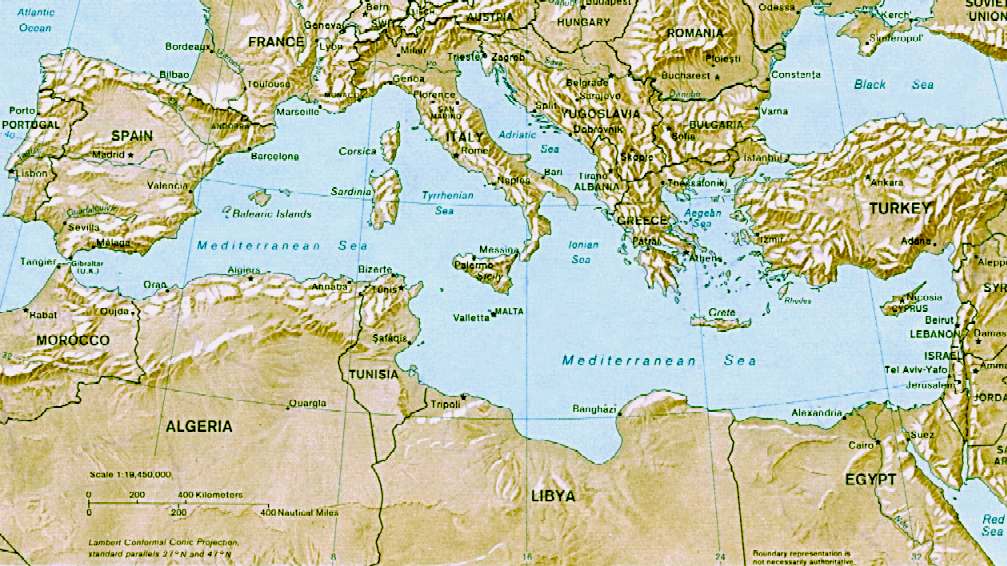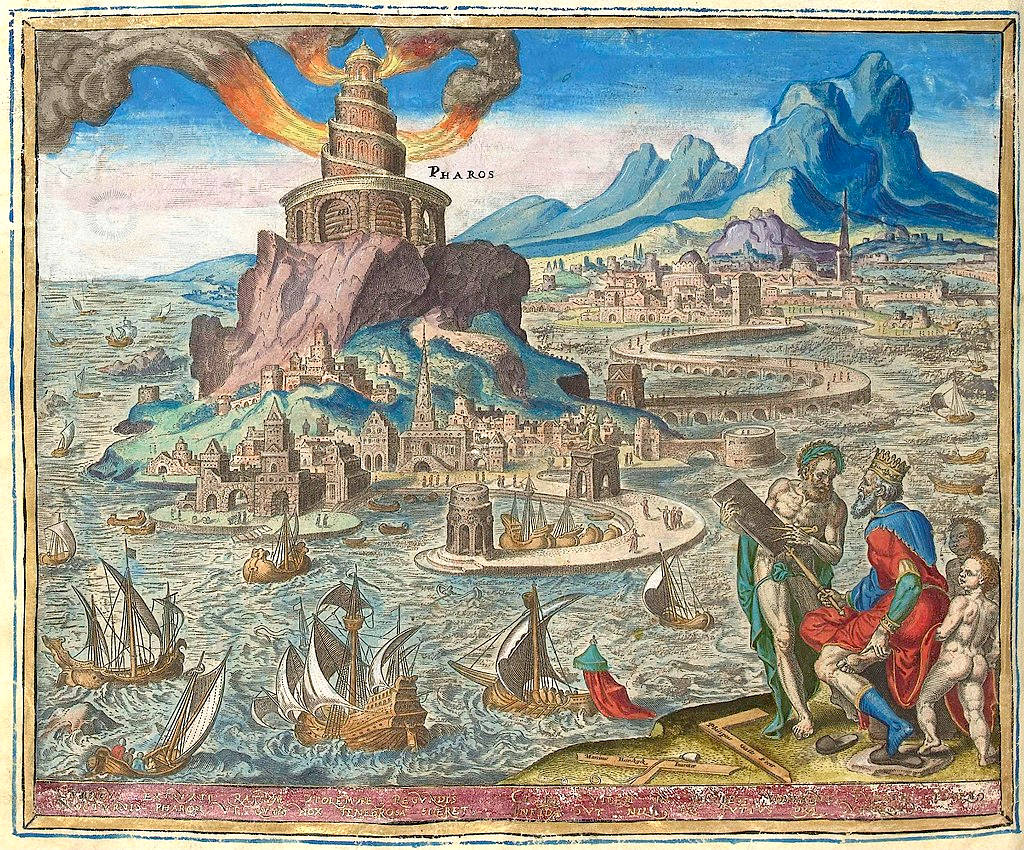
A
painting showing the Lighthouse of Alexandria, by Philip
Galle 1572
The Lighthouse of Alexandria, sometimes called the Pharos of Alexandria, was a lighthouse built by the Ptolemaic Kingdom of Ancient Egypt, during the reign of Ptolemy II Philadelphus (280–247 BC). It has been estimated to have been at least 100 metres (330 ft) in overall height. One of the Seven Wonders of the Ancient World, for many centuries it was one of the tallest man-made structures in the world.
The lighthouse was severely damaged by three earthquakes between 956 and 1323 AD and became an abandoned ruin. It was the third-longest surviving ancient wonder, after the Mausoleum at Halicarnassus and the extant
Great Pyramid of Giza, surviving in part until 1480, when the last of its remnant stones were used to build the Citadel of Qaitbay on the site.
In 1994, a team of French archaeologists dove into the water of Alexandria's Eastern Harbour and discovered some remains of the lighthouse on the sea floor. In 2016 the Ministry of State of Antiquities in Egypt had plans to turn submerged ruins of ancient Alexandria, including those of the Pharos, into an underwater museum.
Legend has it that the people of the island of Pharos were wreckers; hence, Ptolemy I Soter had the lighthouse built to help guide ships into port at night.
Pharos became the etymological origin of the word "lighthouse" in Greek (φάρος), many Romance languages such as French (phare), Italian and Spanish (faro) – and thence into Esperanto (faro) – Catalan, Romanian (far) and Portuguese (farol), as well as Swedish and Danish (fyr), and even some Slavic languages like Bulgarian (far). In French, Portuguese, Turkish, Serbian and Russian, a derived word means "headlight" (phare, farol, far, фар, фара).
ORIGIN
Pharos was a small island located on the western edge of the Nile Delta. In 332 BC
Alexander the Great founded the city of Alexandria on an isthmus opposite Pharos. Alexandria and Pharos were later connected by a mole spanning more than 1,200 metres (0.75 miles), which was called the Heptastadion ("seven stadia"
— a stadion was a Greek unit of length measuring approximately 180 m). The etymology of "Pharos" is uncertain. The word became generalized in modern
Greek (φάρος 'fáros'), and was borrowed by Italian and Spanish ('faro') and French ('phare').
The east side of the mole became the Great Harbour, now an open bay; on the west side lay the port of Eunostos, with its inner basin Kibotos now vastly enlarged to form the modern harbour. Today's city development lying between the present Grand Square and the modern Ras el-Tin quarter is built on the silt which gradually widened and obliterated this mole. The Ras el-Tin promontory, where Ras el-Tin Palace was built in the 19th century, represents all that is left of the island of Pharos, the site of the lighthouse at its eastern point having been weathered away by the sea.
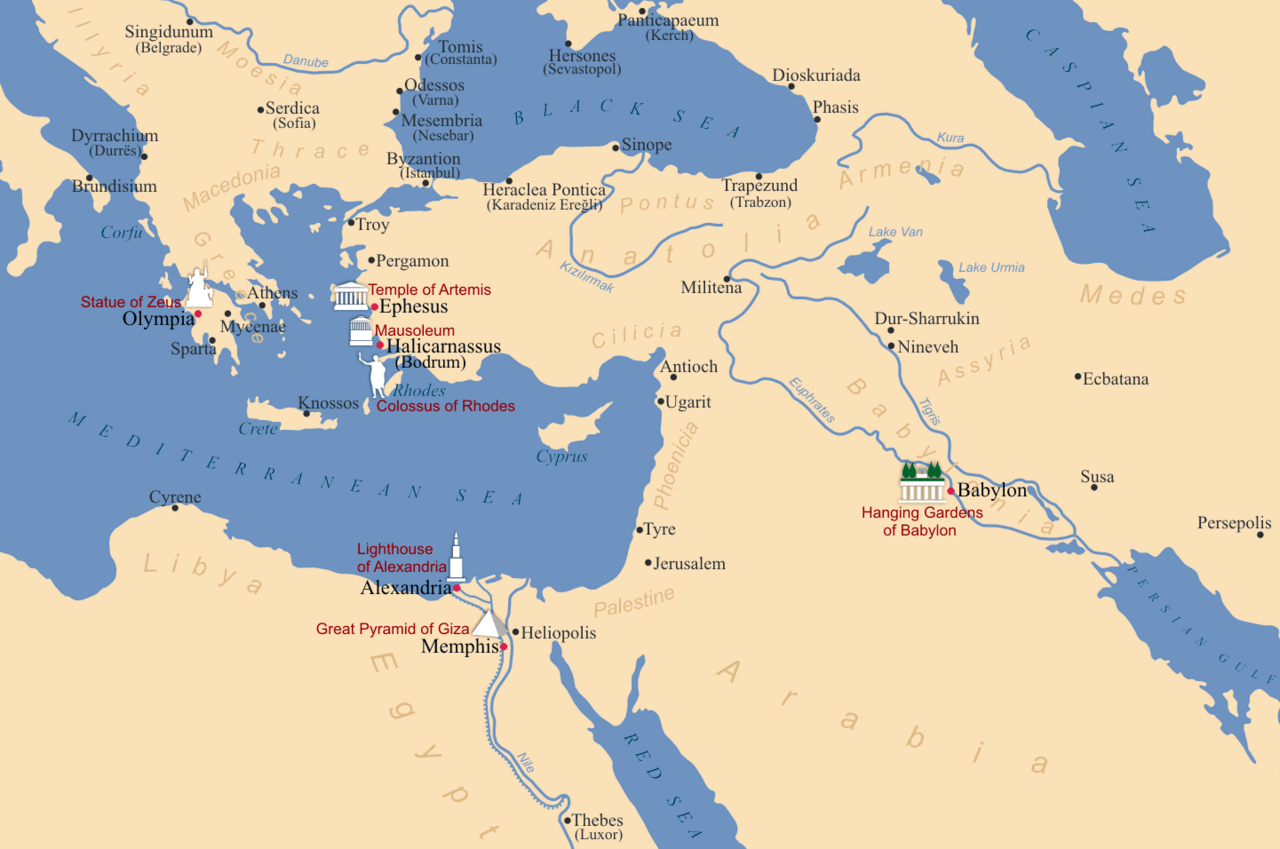
A
map showing the location of the Seven Wonders of the Ancient
World.
CONSTRUCTION
The lighthouse was constructed in the third century BC. After Alexander the Great died, the first Ptolemy (Ptolemy I Soter) declared himself king in 305 BC, and commissioned its construction shortly thereafter. The building was finished during the reign of his son, Ptolemy II Philadelphus, and took twelve years to complete at a total cost of 800 talents of
silver. The light was produced by a furnace at the top, and the tower was said to have been built mostly with solid blocks of limestone and granite.
In his encyclopedic manuscript Geographica, Strabo, who visited Alexandria in the late first century BC, reported that Sostratus of Cnidus had a dedication to the "Saviour Gods" inscribed in metal letters on the lighthouse. Writing in the first century AD, Pliny the Elder stated in his Natural History that Sostratus was the architect, although this conclusion is disputed. In his second century AD educational treatise How to Write History, Lucian claimed that Sostratus hid his name under plaster which bore the name of Ptolemy, so that when the plaster eventually fell off, Sostratus's name would be visible in the stone.
The blocks of sandstone and limestone used in the construction of the lighthouse have been scientifically analysed in order to discover where they originated, with mineralogical and chemical analysis pointing to the Wadi Hammamat quarries, which are located in the desert to the east of Alexandria.
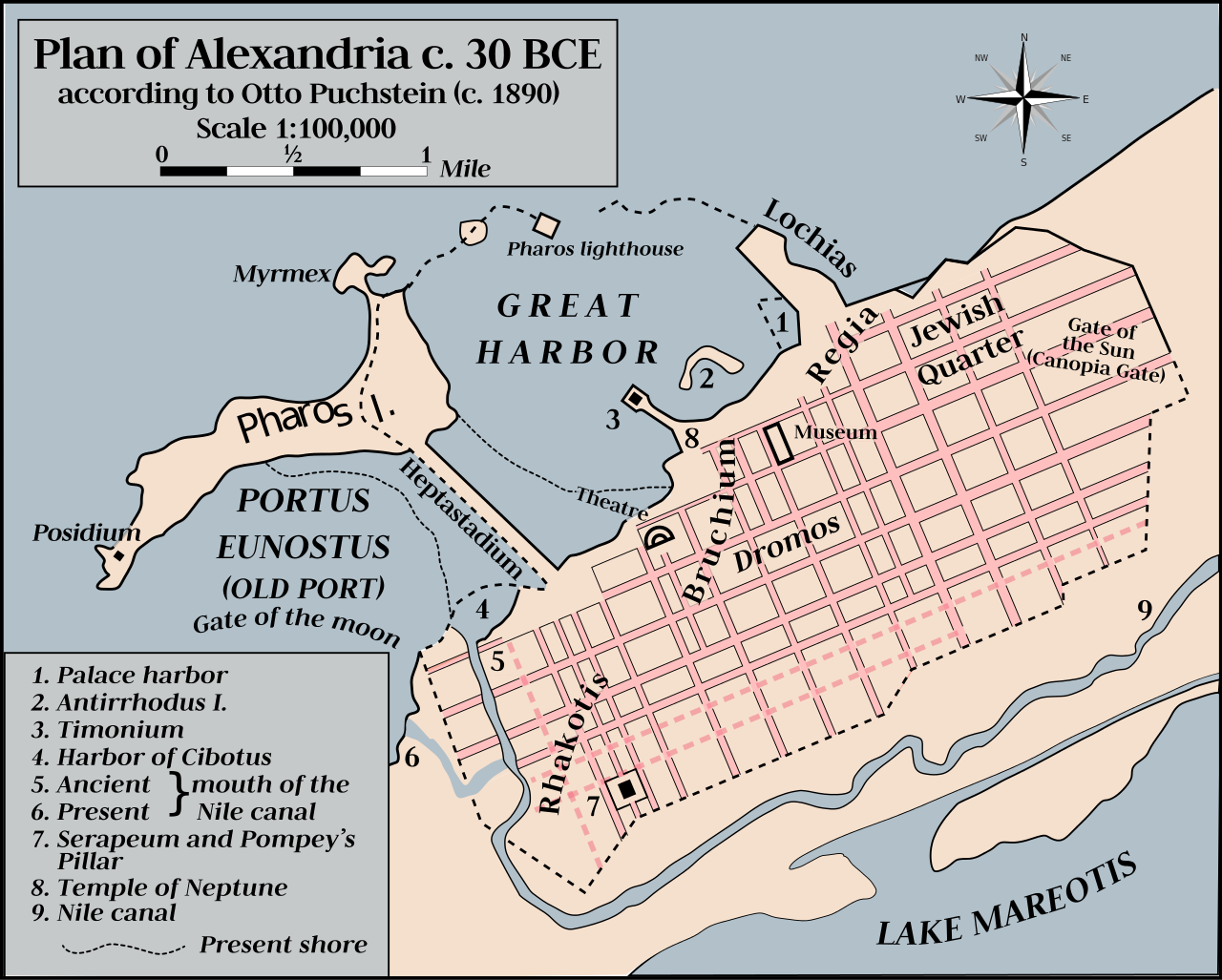
HOW TALL?
Arab descriptions of the lighthouse are consistent despite it undergoing several repairs after earthquake damage. Given heights vary only fifteen percent from 103 to 118 m (338 to 387 ft), on a 30 by 30 m (98 by 98 ft) square base.
The Arab authors indicate that the lighthouse was constructed from large blocks of light-coloured stone. The tower was made up of three tapering tiers: a lower square section with a central core; a middle octagonal section; and, at the top, a circular section. Al-Masudi wrote in the 10th century that the seaward-facing side featured an inscription dedicated to Zeus. Geographer Al-Idrisi visited the lighthouse in 1154 and noted openings in the walls throughout the rectangular shaft with lead used as a filling agent in between the masonry blocks at the base. He reckoned the total height of the lighthouse to be 300 dhira rashashl (162 m).
At its apex was a mirror which reflected sunlight during the day; a fire was lit at night. Extant Roman coins struck by the Alexandrian mint show that a statue of Triton was positioned on each of the building's four corners, and a statue of Poseidon or Zeus stood atop.
The fullest description of the lighthouse comes from Arab traveler Abou Haggag Youssef Ibn Mohammed el-Balawi el-Andaloussi, who visited Alexandria in 1166 AD. Balawi provided description and measurement of the interior of the lighthouse's rectangular shaft. The inner ramp was described as roofed with masonry at 7 shibr (189 cm, 6.2 ft) noted as to allow two horsemen to pass at once. In clockwise rotation, the ramp held four stories with eighteen, fourteen, and seventeen rooms on the second, third, and fourth floors, respectively.
Balawi accounted the base of the lighthouse to be 45 ba (30 m, 100 ft) long on each side with connecting ramp 600 dhira (300 m, 984 ft) long by 20 dhira (10 m, 32 ft) wide. The octangle section is accounted at 24 ba (16.4 m, 54 ft) in width, and the diameter of the cylindrical section is accounted at 12.73 ba (8.7 m, 28.5 ft). The apex of the lighthouse's oratory was measured with diameter 6.4 ba (4.3 m 20.9 ft).
Late accounts of the lighthouse after the destruction by the 1303 Crete earthquake include Ibn Battuta, a Moroccan scholar and explorer, who passed through Alexandria in 1326 and 1349. Battuta noted that the wrecked condition of the lighthouse was then only noticeable by the rectangle tower and entrance ramp. He stated the tower to be 140 shibr (30.8 m, 101 ft) on either side. Battuta detailed Sultan An-Nasir Muhammad's plan to build a new lighthouse near the site of the collapsed one, but these went unfulfilled after the Sultan's death in 1341.
DESTRUCTION
The lighthouse was partially cracked and damaged by earthquakes in 796 and 951, followed by structural collapse in the earthquake of 956, and then again in 1303 and 1323. Earthquakes propagate from two well known tectonic boundaries, the African–Arabian and Red Sea Rift zones, respectively 350 and 520 km from the lighthouse's location. Documentation shows the 956 earthquake to be the first to cause structural collapse of the top 20+ metres of the construction.
Documented repairs after the 956 earthquake include the installment of an Islamic-style dome after the collapse of the statue that previously topped the monument. The most destructive earthquake in 1303 was an estimated intensity of VIII+ originating from the Greek island of Crete (280–350 km from Alexandria). The stubby remnant disappeared in 1480, when the then-Sultan of Egypt, Qaitbay, built a medieval fort on the larger platform of the lighthouse site using some of the fallen stone.
The 10th-century writer al-Mas'udi reports a legendary tale on the lighthouse's destruction, according to which at the time of Caliph Abd al-Malik ibn Marwan (r. 705–715) the Byzantines sent a eunuch agent, who adopted Islam, gained the Caliph's confidence and secured permission to search for hidden treasure at the base of the lighthouse. The search was cunningly made in such a manner that the foundations were undermined, and the Pharos collapsed. The agent managed to escape in a ship waiting for him.
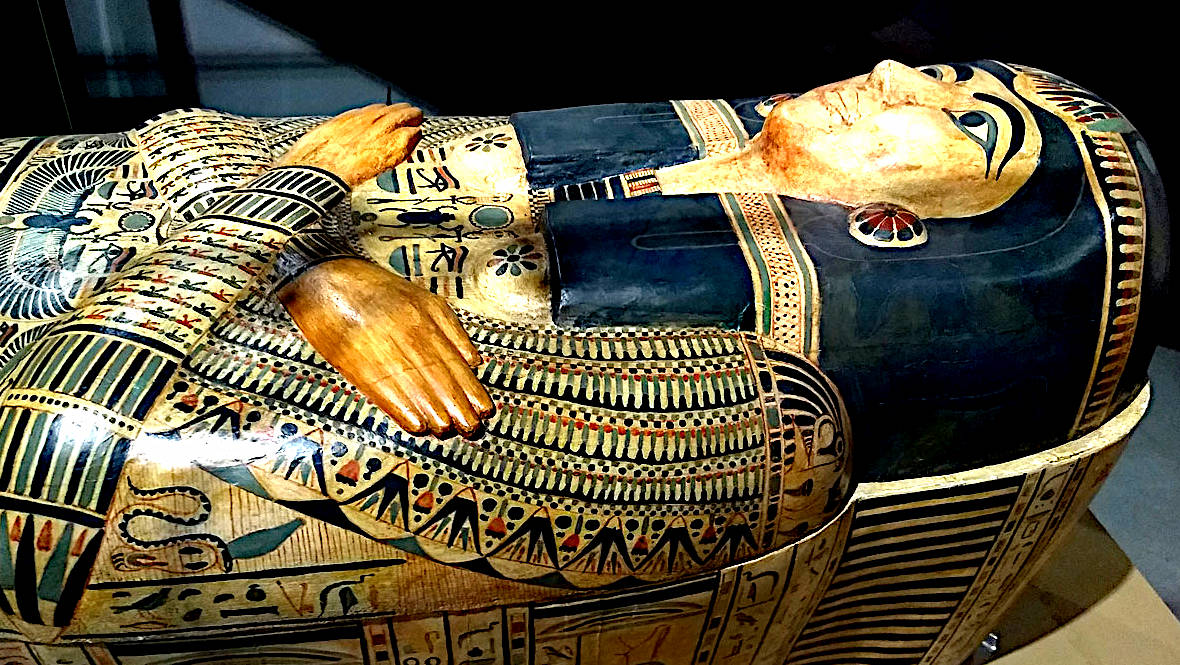
The search for
Cleopatra's elusive tomb, has been at various locations
along the Egyptian coast, including Taposiris Magna.
ARCHAEOLOGICAL REDISCOVERY
In 1916, Gaston Jondet made the first detailed description of the submerged ruins of the old port of Alexandria. He was followed by Raymond Weill in the same year, and by Sir Leopold Halliday Savile in 1940.
In 1968, the lighthouse was rediscovered. UNESCO sponsored an expedition to send a team of marine archaeologists, led by Honor Frost, to the site. She confirmed the existence of ruins representing part of the lighthouse. Due to the lack of specialized archaeologists and the area becoming a military zone, exploration was put on hold.
A team of French archaeologists led by Jean-Yves Empereur re-discovered the physical remains of the lighthouse in late 1994 on the floor of Alexandria's Eastern Harbour. He worked with cinematographer Asma el-Bakri who used a 35 mm camera to capture the first underwater pictures of the scattered remains of collapsed columns and statues. Empereur's most significant findings consisted of blocks of granite
49 - 60 tonnes in mass often broken into multiple pieces, 30 sphinxes, 5 obelisks and columns with carvings dating back to Ramses II (1279–1213 BC).
The cataloging of over 3,300 pieces was completed by Empereur and his team at the end of 1995 using a combination of photography and mapping. Thirty-six pieces of Empereur's granite blocks and other discoveries have been restored and are currently on display in Alexandria museums. Satellite imaging has revealed further remains. In the early 1990s, the underwater archaeologist
Franck Goddio began exploration at the opposite side of the harbor from where Empereur's team had worked.
Satellite and sonar imaging has revealed the additional remains of wharves, houses and temples which had all fallen into the Mediterranean sea as a result of earthquakes and other natural disasters. It is possible to go diving and see the ruins. The secretariat of the
UNESCO Convention on the Protection of the Underwater Cultural Heritage is currently working with the Government of Egypt on an initiative to add the Bay of Alexandria (including the remains of the lighthouse) to a
World Heritage List of submerged cultural sites.
PROPOSED RECONSTRUCTION
Since 1978 a number of proposals have been made to replace the lighthouse with a modern reconstruction. In 2015, the Egyptian government and the Alexandria governorate suggested building a skyscraper on the site of the lighthouse as part of the regeneration of the eastern harbour of Alexandria Port.
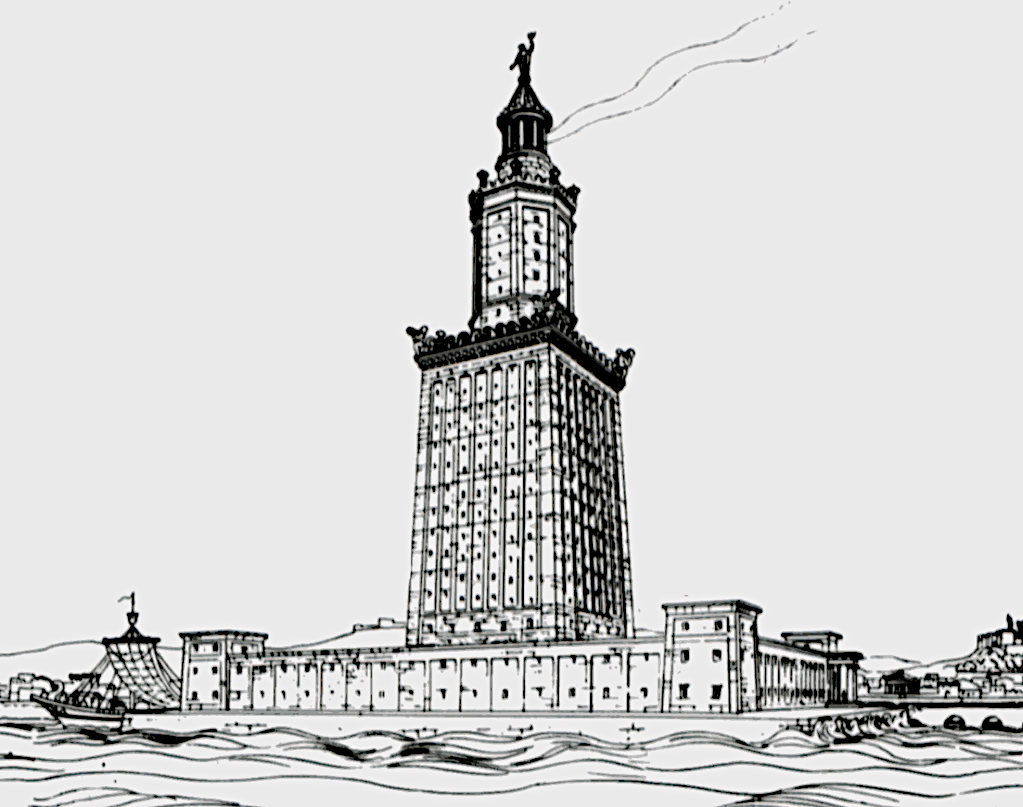
A
drawing of the Lighthouse of Alexandria (Pharos).
THE
SEVEN WONDERS OF THE ANCIENT WORLD
The Seven Wonders of the Ancient World, also known as the Seven Wonders of the World or simply the Seven Wonders, is a list of seven notable structures present during classical antiquity. The first known list of seven wonders dates back to the 2nd–1st century BC.
While the entries have varied over the centuries, the seven traditional wonders are the
Great Pyramid of
Giza, the Colossus of Rhodes, the Lighthouse of Alexandria, the Mausoleum at Halicarnassus, the Temple of Artemis, the Statue of Zeus at Olympia, and the Hanging Gardens of Babylon. Using modern-day countries, two of the wonders were located in Greece, two in Turkey, two in Egypt, and one in Iraq. Of the seven wonders, only the Pyramid of Giza, which is also by far the oldest of the wonders, still remains standing, with the others being destroyed over the centuries. There is scholarly debate over the exact nature of the Hanging Gardens, and there is doubt as to whether they existed at all.





